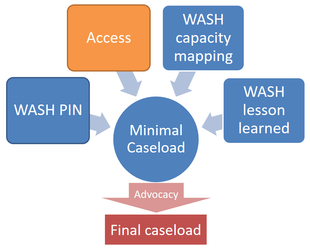Estimation of the humanitarian caseload
Understand the humanitarian profiling system
The cluster caseload represents the total number of people targeted by all partners of a cluster for the planned response. It should not be confused with the Population in Need (PIN), or the population reached or covered:
- WASH People in Need is the total number of people in need for WASH assistance during a humanitarian crisis. They usually cannot be all reached, because of lack of capacity or access problem.
- A more realistic target is therefore defined for the response, called caseload, or population targeted
- People reached by one or more activities are called the population reached, even if these activities are not done using agreed standards, and do not produce the expected change.
- When people are reached by activities done according to agreed standards and leading to the expected change for the beneficiaries, they can be considered as “covered”
| Humanitarian Population Figures | How to calculate WASH Cluster caseload |
There is no consolidated cross-sector method to calculate a cluster caseload. OCHA often provide harmonized methodology at country level. The following approach can nevertheless be used and adapted:
- Use the WASH PIN numbers for each geographical zone as a starting point
- Use data on access to make a first minimal caseload estimation (see following section)
- Use data on capacity to make a second minimal caseload estimation (see following section)
- Consider the gaps between the minimal caseload obtained and the PIN, and estimate the final caseload considering the advocacy for improvement of access and capacity that should be carried out
Use data on access to make a first minimal caseload estimation
The WASH humanitarian caseload is the part of WASH People in Need (PIN) that can will be targeted considering operational constraints. Main constraints are access to target area (road access, security) and operational and technical capacities of partners. If capacity was maximal and access not an issue, the whole population in need could be targeted, and the caseload would be the PIN. But as there are always capacity issues, the PIN must be reduced accordingly.
An estimation of the planned access to target area is required to calculate the WASH caseload. If can be difficult for partners to reach the affected area because of bad road access in rainy season, risk of kidnapping or attacks on humanitarian convoys etc. In that case, only a percentage of the population in need can be reached. For example:
- In regions where there are acute access issues, you can estimate that only half of the PIN can be reached in these regions.
- In regions where access issues are moderate, you can consider that ¾ of the PIN can be reached in these regions
Use data on capacity to make a second minimal caseload estimation
In the same way as for access, an evaluation of partners capacity is required to calculate the WASH caseload. WASH capacity mapping is a long process that can take several months, so if a complete WASH capacity mapping exercise has not been done recently, a lighter and quicker evaluation of capacities needs to be done by the WASH coordination platform before the caseload calculation.
In each geographical zone, based on the capacity of the partners, estimate the maximum number of people that can be reached by the partners. Compare this figure with the minimal caseload defined by access, and make a second round of caseload estimation
Consider priority advocacy for capacity and access improvement and estimate the final caseload
The figure obtained previously is the minimal caseload, considering a static picture of access and capacity. But access and capacity can be improved if the right advocacy is done at the relevant level. You know need to estimate the final caseload if successful advocacy is done. Even if this figure seem unrealistic at first, an important difference between people in need and the people targeted by the response is morally not acceptable as per cluster principles, and the issue must be communicated to the wider audience in advocacy messages.
Key web links

